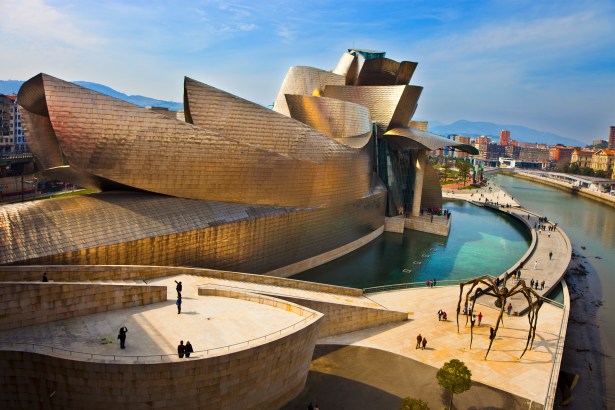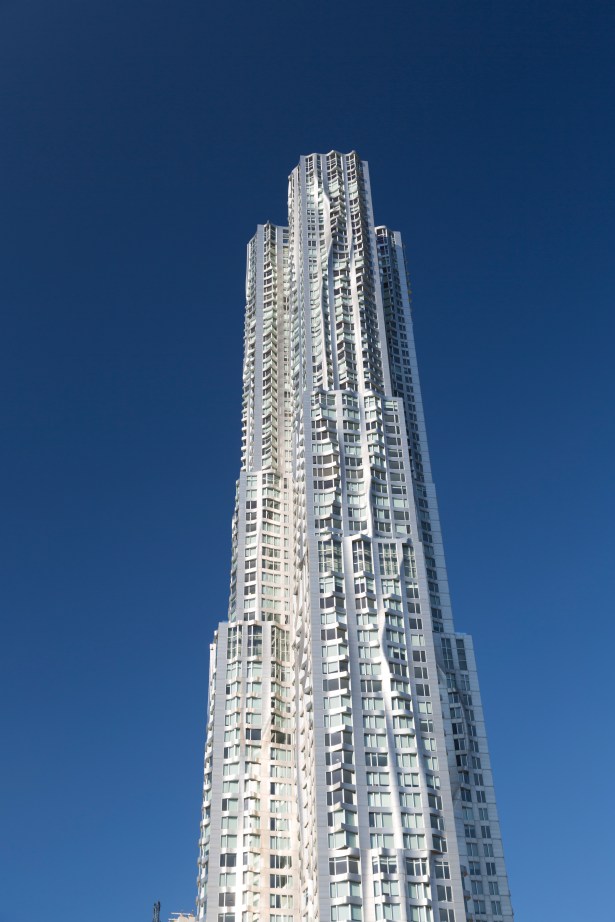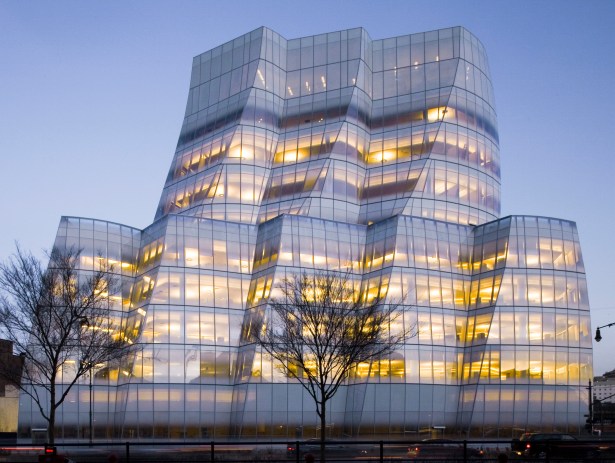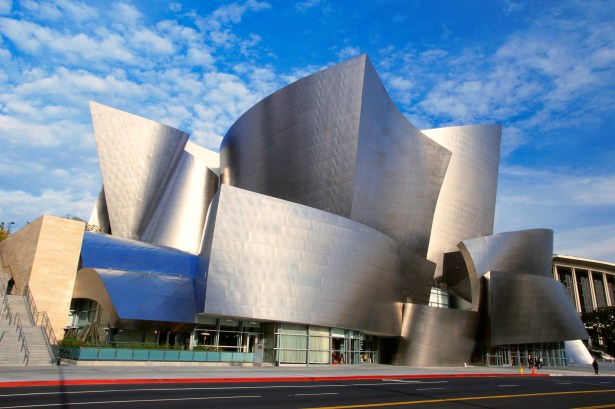Let’s Get Frank: Gehry on New York, LA and the Future of Design
As he approaches his 89th birthday, the famed architect has no plans to slow down
By Alison Stateman February 22, 2018 8:00 am
reprints
“You wouldn’t want me to retire,” Frank Gehry warned. “I’d turn into a monster.”
This kind of candor is typical of Gehry, age 88, who has plenty more iconic projects on the horizon and no plans to slow down anytime soon—a splint on his hand attesting to a broken finger, notwithstanding.
Dressed neatly in chestnut-colored corduroys, black shirt and white Nike slip-on sneakers, Gehry sat close in one of his self-designed bentwood Cross Check chairs for a frank, freewheeling conversation at his headquarters in Playa Vista on the west side of Los Angeles in early January.
Gehry spoke about the humanity that great architecture can convey and the mistaken belief that such work is fiscally out of reach for commercial projects. Even with the soaring nature of his work, including the upcoming Grand Avenue Project in downtown Los Angeles across from his iconic Disney Concert Hall, which is being done in partnership with Related Companies, he pointed to the practical. He broke down the return on investment of his groundbreaking work on the Guggenheim Museum in Bilbao, Spain, which has generated an estimated 650 million euros for the Basque treasury and 5,000 local jobs since its creation in 1997.
But flip a switch, and he’s on to some of the artists who have played the hall. “I’m interested in classical music and the literature surrounding it,” Gehry said. “And a lot of my life is spent with those people. Gustavo Dudamel, Pierre Boulez, Yo-Yo Ma. I love those people, and when I can, I hang out with them, I go to their concerts. Pierre died, but we made a building in Berlin and named it after him—the Pierre Boulez Saal concert hall.”
One of his long-time colleagues Meaghan Lloyd, a partner in his firm, listened in on the talk. “My wife works here, my son works here, my daughter-in-law works here, so it’s kind of a family operation. Meaghan has become family; that’s why she’s overprotective,” Gehry said. (He might also be alluding to, perhaps, the fact that before an interview could be scheduled, a nondisclosure agreement had to be hashed out, which is apparently standard operating procedure with Gehry.)
Overprotective audience or not, the Pritzker Prize-winning architect, who has lived in Los Angeles since relocating from Toronto in 1947, spoke with Commercial Observer about that and much more.

Commercial Observer: Are there any projects looking back that you would have done differently?
Frank Gehry: Yes, every one of them [laughs]. I’m always self-critical. It’s a self-critical process that you go through as you design and that continues. I see things I should have, would have wanted to do differently or better. I would like to make the windows [differently] or some shit like that.
But I am disciplined, so I stop. I know if you open that can of worms, you’ll never get anywhere.
I read an interview in which you said that every time you start a project it’s like starting over in your life.
Yeah, especially for a commercial project. Projects like a museum are a little more ephemeral. They don’t have that same kind of [objective]. They have to be some place you’d be proud to hang your art in.
What do you think of the all-glass skyscraper designs?
They were inevitable, but the way they are being built makes you wonder. They’re kind of banal; why do they have to be that? Most people would say, “Well, it costs money to make architecture.” Well, it doesn’t. Architects can build a building that qualifies as architecture with the same budget as a commercial project.
So, things don’t have to be so cookie-cutter.
They don’t. If you look at our building in Australia for the business school [The Dr Chau Chak Wing facility for UTS Business School in Sydney], which is a brick facade, it’s wiggly brick. You would not think it would be possible in a school building, but we did it for a reasonable, rational budget.
What other buildings have inspired or continue to inspire you, either now or in the past?
The Parthenon [laughs]. No, contemporary, certainly the Notre Dame du Haut in Ronchamp by Le Corbusier. The tower is a bit more difficult. The Einstein Tower in Berlin is one of my favorites. It’s sculptural. It has a humanity to it, a clarity. It’s sited beautifully. The architect who sited it knew how to capture the relationship with the other buildings. I tried to do that with the Beekman Tower [at] 8 Spruce [Street in Lower Manhattan] having the exterior skin talk to the Woolworth Building and the Brooklyn Bridge, so it becomes an ensemble. It creates a visual neighborhood that’s very successful there. You see it, and you feel it when you’re there.
What was your thinking behind the design of 8 Spruce?
Well, the Woolworth Building has a terra-cotta exterior skin and windows that are designed in a vertical. It has stair steps so the tower goes up a certain way, and then it steps back, and then it goes up. On top is a little triangle cap, so we made the Spruce building have stair steps. I didn’t put a top on it out of respect for the Woolworth Building. If we had put a top, we would have been like “look at me, too,” whereas if you don’t, you accrue the value of the Woolworth Building to your space. It becomes part of you.

You were working on Pacific Park [formerly Atlantic Yards] in Brooklyn originally, but that didn’t go forward. They switched gears.
That didn’t go [forward] because it hit the recession. That’s a complication that has nothing to do with architecture. I don’t know what the economics of having a basketball team, basketball stadium are and the difficulty of building over the tracks, but the difficulties of that became exacerbated by the economic drop. They had to punt, as it were, and look for a different way. They were very polite to me. They were fair and gentlemanly about it. They brought in some local guys.
What do you think about the project as it stands?
I haven’t seen it. I can’t do it because I loved that project so much. I’m sorry [laughs]. I’m happy that they did it, but…
In terms of projects, you recently taught a course at Yale University on prison architecture.
Well, there is a group, the Open Society [Foundation], and it’s run by George Soros. They asked us to look at what would we do when designing prisons and jails as they stand with the idea that we’re going to try to lower the incarceration rate and keep an eye on recidivism. What would you do, how would you deal with it? What I decided to do was give it as a project to the university and work with the kids, so instead of one example, we’d have 10. We did it at SCI-Arc [The Southern California Institute of Architecture]. We gave them the jail downtown to do. It’s a beautiful site. They visited jails in L.A. and did research on it. And they came up with 10 or so solutions. They were more like campuses. Some of them were beautiful ideas so they’re going into some sort of book they are using. I teach at Yale every other year. The term just ended two weeks ago, and they were given the Cheshire [Correctional Institution] prison in [Cheshire] Connecticut and some of the same problems.
Was that emotional for you working on a project like this?
Yeah. It was sad to be involved in it. I had a hard time myself. The facilities are terrible. A lot of my time is now spent on philanthropy. We’re very involved with the [Los Angeles River].
Can you tell me about that project, where it stands, what’s needed? [Gehry was brought on board by River LA, the nonprofit group that was founded in 2009 by the city of Los Angeles to coordinate policy on the river.]
Living in L.A. all these years, I was not interested in the L.A. River. I knew it flooded. I knew people died. I knew people were trying to make it a recreation space, a habitat space. I met some of those people who were very committed to that. I felt that was a nice thing they were doing. It just wasn’t my thing, so I didn’t get into it. I was called by some of [Mayor Eric Garcetti’s] friends and supporters from the movie industry who came to my office.
When was that?
Four years ago. And they said you know New York just built a High Line and it’s really successful. We have 51 miles of river. Could you take a look at it and see if you could turn it into something like the High Line? And I looked at them and said I thought the High Line was a relic, rusting railroad bridge. It was left over from a former era that was not being used and nobody wanted to tear it down so there it was.
What do you think of the High Line?
I thought it was interesting, but…it’s not a lasting thing. The thing that’s different about the L.A. River than the High Line is that the L.A. River is a flood-control project. That meant that water is coming from the hills and gathering. Then somebody had the brilliance to build a concrete channel to take care of it, so it didn’t flood. Then they sold all the land right up to the edge of it. So now what do you do? The [U.S. Army] Corps of Engineers were studying habitat and recreational studies and planning biking and swimming and hiking and kayaking.
We studied the river for three years and created an index for it, which is online and very thorough. It analyzes the health problems, the economics, the dangers, the pluses and minuses of it. We could not see in our study a way to use it for recreation, but since the Corps of Engineers were working on a plan for recreation, who were we to dismiss it?
They were saying it only flooded 2 percent of the time, so therefore it’s not a big deal. The reality is that the channel is designed for that flood. Even though 98 percent of the time it is empty, 2 percent of the time I call it Godzilla, [and it] comes and reams your butt. It’s dangerous, and when that happens, it takes out people all along the river. You have to stay with the original idea from the Corps of Engineers.
What are your thoughts about the wave of commercial development that’s been happening in downtown L.A.?
It looks like practically every other city in the world.
What’s missing?
It’s crappy. I don’t recognize it as L.A. anymore.
What happened? What made it more “L.A.” before?
City Hall had more power. The buildings seemed to speak more to the city. A few of the towers were O.K., but that barrage of new stuff that’s being done now, it’s mostly with foreign investors that have no real L.A. commitment. They’re just coming in. They don’t want to talk to people like me. When you are a big foreign developer or even the L.A. ones [they think] there is something mystical that I’m going to do that’s going to cost more. It doesn’t, but they’d rather work with people who sort of work with everybody so they all look the same. You can’t really pick out much that is unique in downtown L.A. Harry Cobb’s building, the Library Tower [renamed the U.S. Bank Tower in 2003], that was kind of special, and Cesar Pelli did a building [777 Tower] that’s kind of white, around Eighth or Ninth Street, that’s still there. It’s very simple, very to the point, very beautiful. It has a nice humanity about it.

I wanted to ask you about the IAC building at 555 West 18th Street, your first freestanding structure in New York City. Didn’t Barry Diller want glass versus the metal you originally planned to use?
Barry Diller was not deeply involved with me on the design in the beginning. Marshall Rose was the partner in charge. Marshall worked with us to develop the design. We met with Barry intermittently, and because Barry is Barry, he had things to say which we accommodated. He was very outspoken about what he didn’t like and what he did like. And, by accident, the first models were made with a white plastic, and he loved that, and he said, “I want a white building.”
Do you find it different working in New York, L.A. and internationally?
I had a good time working in Spain, in Bilbao. The Basques are incredibly precise people. They live up to their promises, and even without a contract, you can count on them. It was great. I consider it almost a second home, a second family, and I go there all the time for the people more than the building.
The Disney Concert Hall is so different than the image many may have of traditional Disney. What was the reaction initially?
Well, Lillian [Disney] was one of the benefactors. I spent time with her, and she was crazy nice, a wonderful lady, fun to be with. She told me stories about Walt [Disney] all the time. Her taste level was not…she liked little cottages of brick and stuff. She even sent me a picture once of a little brick cottage.
Oh, is that the direction she wanted you to go in?
She said, “Could you go more in this direction?” And we had a little bit of a misfire for a while. She loved the interior. The exterior she had trouble with.
What brought her around? Obviously, what you created was very different from a little brick cottage.
I was not shoving it down her throat. I wasn’t giving her a hard time, but I said, “I’m not going to go with a little thatched roof cottage. That’s just not going to happen.” Her daughters, Diane and [Sharon] called me and said, “Mom said we should take over on the building because we love what you’re doing and she trusts us.”
Diane saved it. Diane Disney Miller saved the building on all counts and supported me through thick and thin. I barely knew her. I did not spend time trying to convince her. I asked her why. She said she remembered her father coming home from the studio being beaten up aesthetically over his designs, and she said this felt so much like that and she wanted to cut through that to give me a wide berth. Everybody now on the Philharmonic board credits her with having had the strength of character to see this through and make sure it was architecturally in every way consistent.

Are there any architects working today that you admire?
Yeah. There are a lot of them. It’s hard to pick one out, and then the other ones will be pissed off [laughs]. I like Rem Koolhaas and Zaha Hadid, who passed away. There’s a guy Greg Lynn, who I love dearly. He’s not doing the kind of architecture that we’re talking about. He’s doing industrial design.
I know you developed technology for your designs that weren’t possible before.
O.K., now you’re opening the box. Thirty years ago, sitting in that seat right here was the CEO of Dassault Systemes. We had used his software in CATIA [a software suite for computer-aided design] to build the Fish in Barcelona and then to build the Guggenheim in Bilbao. It enabled us to build it on budget and save money. It was precise. We then used that software to do a building for another architect in Hong Kong. Our tech team that we used in-house, we sent them there to work on this building and saved 18 percent of the building cost. And then at Beekman Tower at 8 Spruce, we did the exterior skin with no change orders on the skin, which is a wiggly surface, which is complicated.
So, I had the guy sitting here, and I said your software is too expensive for our industry. It’s a great big industry, can you get involved? That was 25 years ago, and he’s slowly getting involved, but he did not embrace it like he needed to. Dassault developed this thing called Revit, and they sold it because it was an inferior system. Now, that’s the system that’s being sold by Autodesk as the reigning system for tech for the construction industry, and it’s very flawed. It sucks in fact, and you can quote me. But it’s the only one that’s out there that’s usable. We created something called Digital Project, which is an add-on to CATIA, but still the software from the French is expensive.
So, there needs to be a solution.
There are solutions. I don’t know why nobody is going there. I had a separate tech company [Gehry Technologies] doing only that, and I just couldn’t run it and my practice. So, we sold it to Trimble [in 2014], and they’re continuing to develop it. It’s going to take a couple of years the way they’re going. We’re trying to help them.
You know they build airplanes paperless. That software exists, and a building is a lot simpler than a freakin’ airplane. We should be able to build buildings paperless which means, if you do it right, you should be able to go through the building department in a few days instead of six months.
What do you think of this tendency to make architects into stars?
Oh, starchitect. I hate that word. The press, you should write this, the press invented the word “starchitect,” and then they call us that, and they demean us for being one in their minds. It’s nasty stuff.
Let’s go into tributes. The Simpsons 2013 episode you were featured on, how did that come about? [The screensaver on Gehry’s smartphone is of his Simpsons doppelganger]
I was at a TED conference, and I met Matt Groening [creator of The Simpsons]. He’s a nice guy, and he asked me to be on The Simpsons, so I did. He now happens to be my neighbor. He lives two doors from me in Santa Monica.
That was an interesting one because they show me crumbling these papers and saying, “Frank Gehry, you’re a genius.” Everybody thinks that I crumble paper to make buildings. People will come up to me since that episode, kids would come to me with a crumbled piece of paper and ask me to sign it. So then since it’s so much in the air, I made a crumbled paper bear. Do you see it there? We have one full-sized at my house.
Do you ever think of retiring?
No. Don’t say that! I’m only 88 for god’s sake.


